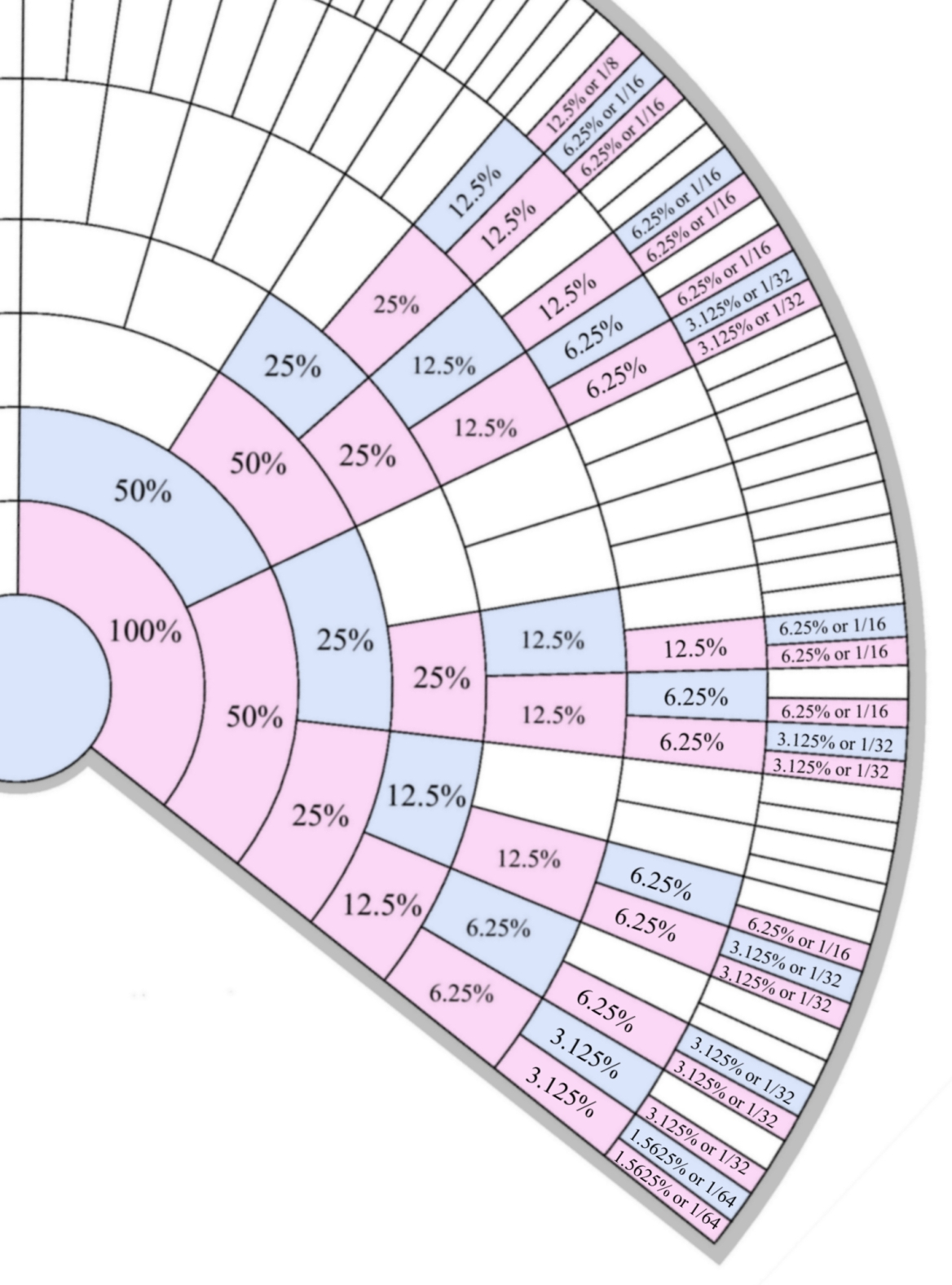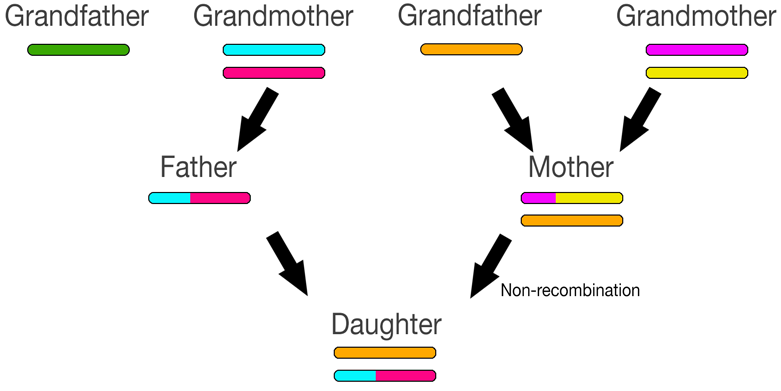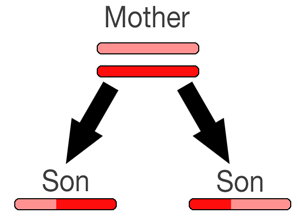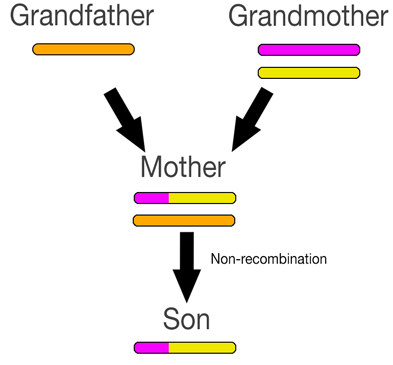
by Jared Smith
Please contact me if you have any corrections or clarifications on the following.
First, a few basic premises:
This establishes two patterns that can be helpful in X-DNA genealogical research:
Assuming that how the X chromosome passes from mother to child is always a 50-50 combination of both of her X chromosomes (i.e., a perfect combination of the baby's grandfather's and grandmother's X chromosome), you could expect inheritance patterns and prevalence as in the chart below.
PLEASE keep reading below to learn why the numbers on this chart are NOT ACCURATE!

You'll notice that you're more likely to carry more of the X-chromosome from ancestors along lines with father-daughter occurrences.
A typical recombined X chromosome passed from mother to son might look like this (note that in this and all other charts, ONLY the X chromosomes are shown and that color is used only to identify X chromosome segments):

Remember that X isn't passed from father to son, and that sons only have one X chromosome which is a combination of his mother's two X chromosomes.
From parents to daughter, it might look like this:

One chromosome is a copy of the father's and the other is recombined from the mother's X chromosomes.
If you throw in another generation, things get much more complex (only X chromosomes are shown).

Notice that the X-chromosome the daughter got from her father has only one recombination whereas the one she got from her mother has two recombinations. Again, father-to-daughter events are not subject to recombination. An X-DNA test would likely show a stronger relationship to the daughter's paternal grandmother (and her descendants) than to her maternal grandmother or grandfather (and their descendants)... except that things are NOT this straightforward...
On average, you get around half of your DNA from your mother and half from your father. But this does not mean that each chromosome is inherited 50-50. Recombination (also called crossover) may occur at varying amounts - you may get 80% of the chromosome your mother got from her father and 20% of the chromosome she got from her mother. This means that your X-DNA matches might be found predominantly on one family line over another. This makes the prevalence chart above unreliable in determining actual possible matches.
A few known facts about X chromosome recombination:
Additionally, there are instances where a mother's X chromosomes do not recombine at all - she instead passes an exact copy of one of her X chromosomes to her child. This can result in an entire family line where you will not have any X-DNA matches. We're not sure how often non-recombination occurs. Some studies have suggested only 3% of mother-child events don't have X chromosome recombination, though analysis of DNA test results suggests a slightly higher rate. The rate of non-recombination seems to be genetic - it occurs more often in some families than others.
Consider the following chart where non-recombination has occurred:

You can see that the X-DNA connection from the daughter to her maternal grandmother has been broken. They share none of the same X-chromosome markers. While this means that the daughter will have no X-matches to cousins on her maternal grandmother's line, it also means that she has a 100% match to her maternal grandfather, so any matches she does have are more likely to be on this line. Identifying where non-recombination has occurred or which lines are X-DNA dominant can be valuable to your genetic genealogy research.
When comparing your X-DNA data with someone else, it's vital to understand half and full matches. These terms are used to describe how your X chromosome SNP markers match another's. The matching tools (such as GEDmatch) will compare the single X chromosome of a man to both X chromosomes of a women. Any of a man's X chromosome SNPs that match EITHER of the woman's X chromosome SNPs will be considered a half match - he only matches one of her X-chromosomes (he can't match both because he only has one X chromosome with which to compare). These display at GEDmatch.com as yellow on the chromosome chart:

This screenshot shows the GEDmatch X-DNA Comparison between myself (a male) and a female cousin. The blue bars indicate matching segments larger than the defined threshold (7cM in this case). The yellow indicates half matches, the green lines indicate full matches, and the red indicates no match. The green lines are full matches only by chance (my cousin's SNPs for both X chromosomes are the same at these locations) - it's the large blocks defined with blue that are of interest.
Full matches for long segments of SNPs (almost) always occur only when comparing men to men. This is because the SNPs of one X chromosome are compared to the SNPs of only one other X chromosome.

This screenshot shows my comparison to an unknown male cousin. Notice the full matches in green and no yellow half matches. This is a match I should look into further. Additionally, because the overlap between both charts above are primarily in the same regions, this means that this unknown cousin is most likely related to me along the same family line as my known female cousin above.
Some matching guidelines to remember:
Of note is that the total may be slightly less than 196cM due to testing errors or oddities and recombination that usually occurs at the beginnings and ends of the X chromosome.
A 100% match does not always indicate that X chromosome non-recombination has occurred. And neither does a 0% match.
... but this often causes genetic genealogist to think it happens more frequently than it really does.
Consider two brothers who are not matches. One would assume that non-recombination has occurred and that one brother got his grandmother's X chromosome and the other got his grandfather's X chromosome. This is an unsafe assumption:

The brothers above would not be an X-match, but this does not mean recombination has not occurred - it's possible that recombination happened for both of them, but that it occurred in exactly opposite locations (this is not uncommon).
Because full matches in men indicate portions of the X chromosome that have remained intact over potentially numerous recombination events, you should consider male-male X-matches with much more interest than any other matches.
Consider this chart again...

In this chart, the daughter will be a 100% (196cM) half match to everyone listed EXCEPT her paternal grandfather (no X-chromosome on this path) and her maternal grandmother (the non-recombination results in her not matching any SNPs here). There are no full matches.
What if the daughter had instead been a son and had inherited the non-recombined X chromosome from his mother...

The son would be a 100% (196cM) half match with his mother, but a 100% (196cM) full match with his mother's father. It is possible (though quite rare) that you could be a 100% match to someone many generations back - and as such, you can share notable X-DNA with a very distant cousin.
It's important to note that when comparing any woman, GEDmatch does not indicate which X chromosome you match (the one from her maternal grandmother or the one from her maternal grandfather), only that a match exists. This means that you can only reliably detect non-recombination events by testing grandparents. And even then it can be difficult...

In this example, the son would be a 100% (196cM) half match to both his mother and his grandmother. There would be no way using only these 3 tests to know whether recombination has or has not occurred. You could discover this only by testing the maternal grandfather and discovering that there was no X-match with him.
As you can see, if you're unable to test grandparents (especially maternal grandfathers or paternal grandmothers), X-DNA data will be less useful to you. You can compare X-DNA data for siblings and/or cousins, but piecing together the puzzle is difficult due to the variability of the X chromosome.
While X-DNA can be a difficult and unpredictable aspect of genetic genealogy, understanding how it works can help you unlock ancestry mysteries.